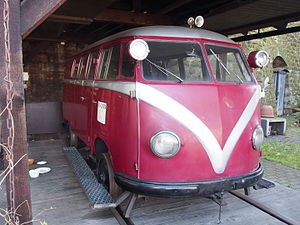DB class Klv 20
| Klv 20 | |
|---|---|
|
Klv 20 in the DGEG railway museum Neustadt / Weinstrasse
|
|
| Numbering: | 5001–5015 ( Beilhack ), 5016–5030 ( WMD ), 5031 (prototype) |
| Number: | 31 |
| Manufacturer: | Beilhack, WMD |
| Year of construction (s): | 1954-1955 |
| Type : | 1A bm |
| Gauge : | 1435 mm ( standard gauge ) |
| Length: | 4100 mm |
| Height: | 1900 mm |
| Width: | 1700 mm |
| Total wheelbase: | 2400 mm |
| Empty mass: | 1400 kg |
| Loading mass: | 800 kg |
| Wheel set mass : | 1100 kg |
| Top speed: | 70 km / h |
| Installed capacity: | 17.65 kW (24 hp); 21 kW (28 hp) |
| Driving wheel diameter: | 550 mm |
| Motor type: | air-cooled four-cylinder 4-stroke gasoline engine |
| Power transmission: | mechanical four-speed gearbox |
| Tank capacity: | 40 l |
| Brake: | hydraulic foot pedal brake mechanical parking brake |
| Seats: | 7th |
The small car Klv 20 is an auxiliary vehicle - railway maintenance office - draisine - for route travel purposes and maintenance work on railway systems (e.g. signaling and telecommunications systems) of the German Federal Railroad .
development
In 1954/1955 the Deutsche Bundesbahn ordered new works office draisines. After a prototype with a VW bus - bodywork from T1 had been appointed, were at Beilhack and WMD per 15 pieces ordered. It turned out to be advantageous to use high-volume technology from automotive engineering. The body was adopted, as was the air-cooled boxer engine with 28 hp. The VW body was placed on a welded frame. By 1977 all vehicles at DB had been taken out of service. Some of them were taken over by other railway companies or museums. Seven vehicles are still preserved.
drive
The Klv 20 are equipped with the air-cooled VW industrial engine with 28 HP, which is similar to the engine of the VW Beetle. The power is transmitted via a clutch and manual transmission from the automotive industry, there are four forward gears and one reverse gear. The maximum speed is 70 km / h.
Lifting and rotating device
Like other small cars, the Klv 20 are equipped with a mechanical lifting and rotating device. It consists of a steel profile frame located in the center under the vehicle, which can be lowered from the rear end of the vehicle using a hand crank and is then supported on the rails. The vehicle is thereby supported in the area of its center of gravity, so that one person is sufficient to turn it in the other direction of travel or to launch it at right angles to the track.
literature
Oliver Strüber: The "great-grandchildren" of Mr. Drais . In: railway magazine . No. 8 , 2017, ISSN 0342-1902 , p. 48-51 .

